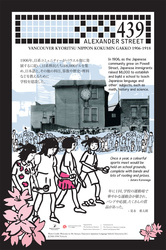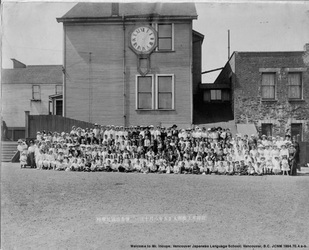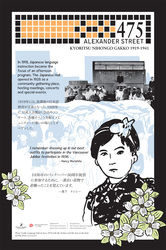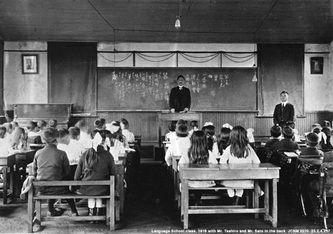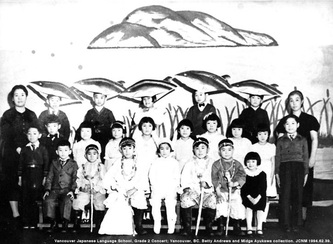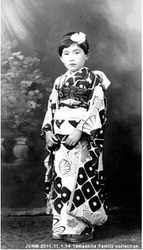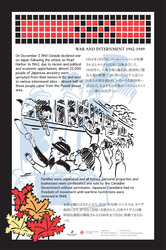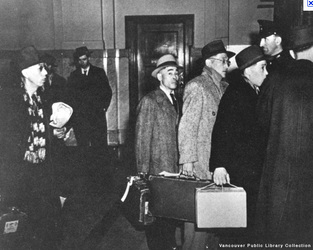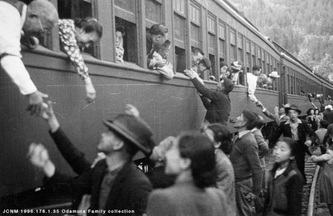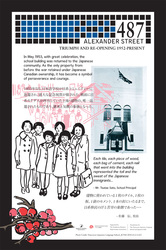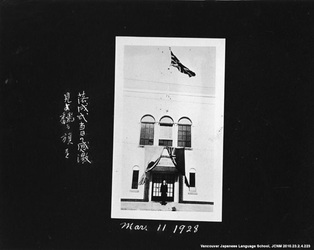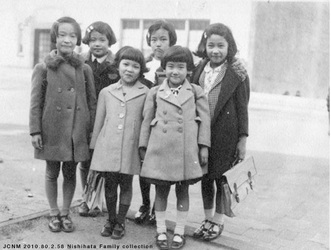487 Alexander Street - Vancouver Japanese Language School
439 Alexander Street
VANCOUVER KYORITSU NIPPON KOKUMIN GAKKO 1906-1918
In 1906, as the Japanese community grew on Powell Street, Japanese immigrants raised $8,000 to establish and build a school to teach Japanese language and other subjects, such as math, history and science.
1906年、日系コミュニティーがパウエル街に発 展するに従い、日系移民たちは8,000ドルを集 め、日本語と、その他の科目、算数や歴史・理科 などを教るために 学校を建設した。
"Once a year, a colourful sports meet would be held on school grounds, complete with bands and lots of rooting and prizes." - Jutaro Korenaga
" 年に1回、学校の運動場で 華やかな運動会が催され、バンドや応援、たくさんの賞品があった。" - 是永 重太郎
VANCOUVER KYORITSU NIPPON KOKUMIN GAKKO 1906-1918
In 1906, as the Japanese community grew on Powell Street, Japanese immigrants raised $8,000 to establish and build a school to teach Japanese language and other subjects, such as math, history and science.
1906年、日系コミュニティーがパウエル街に発 展するに従い、日系移民たちは8,000ドルを集 め、日本語と、その他の科目、算数や歴史・理科 などを教るために 学校を建設した。
"Once a year, a colourful sports meet would be held on school grounds, complete with bands and lots of rooting and prizes." - Jutaro Korenaga
" 年に1回、学校の運動場で 華やかな運動会が催され、バンドや応援、たくさんの賞品があった。" - 是永 重太郎
475 Alexander Street
KYORITSU NIHONGO GAKKO 1919-1941
In 1919, Japanese language instruction became the focus of an afternoon program. The Japanese Hall opened in 1928 as a community gathering place, hosting meetings, concerts and special events.
1919年には、放課後の日本語 教育が主体となった。1928年に、日系人会館が、会合やコン サート、各種イベントを催すコミュニティーの集いの場としてオ ープンした。
"I remember dressing up in our best outfits to participate in the Vancouver Jubilee festivities in 1936." - Nancy Morishita
" - 森下 ナンシー1936年のバンクーバー50周年祝祭に参加するために、一番良い着物で着飾ったことを覚えています。" - 森下 ナンシー
KYORITSU NIHONGO GAKKO 1919-1941
In 1919, Japanese language instruction became the focus of an afternoon program. The Japanese Hall opened in 1928 as a community gathering place, hosting meetings, concerts and special events.
1919年には、放課後の日本語 教育が主体となった。1928年に、日系人会館が、会合やコン サート、各種イベントを催すコミュニティーの集いの場としてオ ープンした。
"I remember dressing up in our best outfits to participate in the Vancouver Jubilee festivities in 1936." - Nancy Morishita
" - 森下 ナンシー1936年のバンクーバー50周年祝祭に参加するために、一番良い着物で着飾ったことを覚えています。" - 森下 ナンシー
WAR AND INTERNMENT 1942-1949
On December 7, 1941 Canada declared war on Japan following the attack on Pearl Harbor. In 1942, due to racism and political and economic opportunism, almost 22,000 people of Japanese ancestry were uprooted from their homes in BC and sent to various internment sites – almost half of those people came from the Powell Street area.
1941年12月7日、パール・ハーバーが攻撃されるとカナダは日 本に宣戦布告した。1942年に、人種差別と政治的、経済的ご都合主義の影響で、BC州の2万2千人近くの日系人が家を追われ、いろいろな収容所へ送られ た。およそその半数がパウエル・ストリート一帯の住民だった。
Families were separated and all homes, personal properties and businesses were confiscated and sold by the Canadian Government without permission. Japanese Canadians had no freedom of movement until wartime restrictions were removed in 1949.
家族は離ればなれになり、住宅・所有物・ビジネスは、カナダ 政府により、許可なく没収・売却された。日系カナダ人は戦 時居住制限が解除される1949年まで自由に移動できなかった。
On December 7, 1941 Canada declared war on Japan following the attack on Pearl Harbor. In 1942, due to racism and political and economic opportunism, almost 22,000 people of Japanese ancestry were uprooted from their homes in BC and sent to various internment sites – almost half of those people came from the Powell Street area.
1941年12月7日、パール・ハーバーが攻撃されるとカナダは日 本に宣戦布告した。1942年に、人種差別と政治的、経済的ご都合主義の影響で、BC州の2万2千人近くの日系人が家を追われ、いろいろな収容所へ送られ た。およそその半数がパウエル・ストリート一帯の住民だった。
Families were separated and all homes, personal properties and businesses were confiscated and sold by the Canadian Government without permission. Japanese Canadians had no freedom of movement until wartime restrictions were removed in 1949.
家族は離ればなれになり、住宅・所有物・ビジネスは、カナダ 政府により、許可なく没収・売却された。日系カナダ人は戦 時居住制限が解除される1949年まで自由に移動できなかった。
487 Alexander Street
TRIUMPH AND RE-OPENING 1952-PRESENT
In May 1953, with great celebration, the school building was returned to the Japanese community. As the only property from before the war retained under Japanese Canadian ownership, it has become a symbol of perseverance and courage.
1953年5月、日本語学校が日系コミュニティーに返還され、盛大な記念祝賀が催された。戦前に日系カナダ人が所有していた土地・建物の、唯一返還されたものであり、継承と気概の象徴となった。
"Each tile, each piece of wood, each bag of cement, each nail that went into the building represented the toil and the sweat of the Japanese immigrants…" - Mr. Tsutae Sato, School Principal
"- 佐藤 伝、 校長 建物に使われている1枚のタイル、1枚の 板、1俵のセメント、1本の釘にいたるまで、日系移民の汗と苦労の象徴であった・・・" - 佐藤 伝、 校長
TRIUMPH AND RE-OPENING 1952-PRESENT
In May 1953, with great celebration, the school building was returned to the Japanese community. As the only property from before the war retained under Japanese Canadian ownership, it has become a symbol of perseverance and courage.
1953年5月、日本語学校が日系コミュニティーに返還され、盛大な記念祝賀が催された。戦前に日系カナダ人が所有していた土地・建物の、唯一返還されたものであり、継承と気概の象徴となった。
"Each tile, each piece of wood, each bag of cement, each nail that went into the building represented the toil and the sweat of the Japanese immigrants…" - Mr. Tsutae Sato, School Principal
"- 佐藤 伝、 校長 建物に使われている1枚のタイル、1枚の 板、1俵のセメント、1本の釘にいたるまで、日系移民の汗と苦労の象徴であった・・・" - 佐藤 伝、 校長
Artist Comments and Additional Information
These four panels make up a complete seasonal set of hanafuda playing cards in this Powell Street rendition.
The first panel dates from 1906 to 1918, where the Language School was known as the Vancouver Kyoritsu Nippon Kokumin Gakko. The big clock was a prominent feature on the building during this time, as shown in the photo alongside families lined up watching an annual sports day relay.
1919 to 1941 the school was known as Kyoristu Nihongo Gakko. Alongside their lessons in Japanese language, other special events like Gakugeikai (school plays) were also participated by school children, as presented by the blue watermark of children wearing fish hat costumes.
In this War and Internment panel, the convergence of two line drawings of historical photographs depicts the struggles endured by the Japanese Canadian community during the internment: a photograph of Japanese Canadian families being removed from the westcoast by train and a photograph of Japanese Canadian men registering into Hastings Park (today known as the Pacific National Exhibition).
By 1949 the community fought to re-open the school. Behind a group of girls standing in their fall coats is a sketch of Japanese Canadian women standing amidst the building's construction. Like a scrapbook layout, one begins to make sense of the building’s complex transition as emphasized by the Vancouver Japanese Language School photograph sits boldly beside the drawings. The building remains the only pieces of property that was returned to the Japanese Canadian community after the war in 1953. Today, the Vancouver Japanese Language School and Hall brings in Japanese Canadian children from all across the Lower Mainland, where children attend classes and learn cultural activities.
